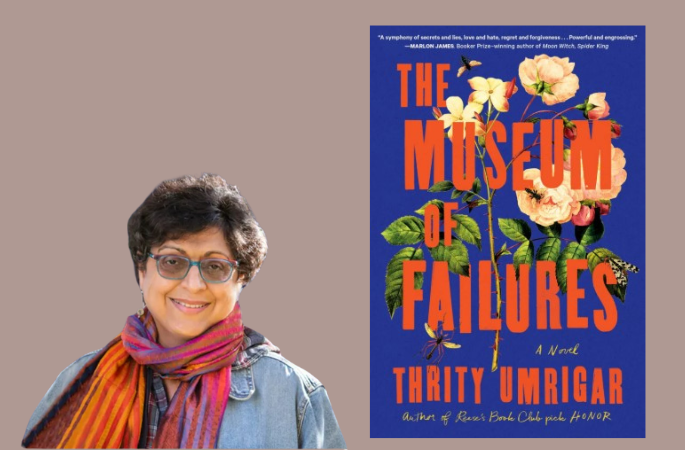Thrity Umrigar’s The Museum of Failures is a searing portrait of betrayal, forgiveness, immigration, cultural complexity, the generation gap, and the long shadow of family secrets, set in India and the United States. While the novel has its strengths—vivid prose, relatable emotions, thought-provoking themes, and a gripping plot that make it a definite page-turner—the writing at times veers toward telling rather than showing, making it somewhat challenging to forge a deep connection with the characters.
The book’s protagonist, Remy, is a Parsi man born into an upper-middle-class family in Bombay. Remy shares a very close relationship with his father, Cyrus, whose demise marks a turning point in Remy’s relationship with his homeland. In stark contrast, Remy’s mother, Shirin, is portrayed as detached and emotionally unavailable—even unkind—creating a rift that shapes much of his emotional world. The adult Remy, having achieved the American dream—successful career, loving marriage to Kathy, a pediatrician, and a life of economic stability—makes a trip back to India to adopt a baby from an unwed Parsi mother and to see his elderly mother, who, unbeknownst to him, has become mute and emaciated. Guilt-ridden for having neglected his responsibilities as her only child, Remy devotes himself to helping Shirin recover, only to discover a dark family secret that forces him to confront past events and reevaluate his relationships, especially with his mother.
Thrity Umrigar’s exploration of family secrets and the resultant trauma traveling down generations is undeniably riveting. At its best, Umrigar’s writing is evocative and emotionally resonant, effectively capturing the pain of estrangement, the longing for connection, and the power of reconciliation. Themes of cultural identity and the immigrant experience are also woven throughout the narrative, as Remy navigates feelings of isolation and alienation in America while maintaining a love-hate relationship with his birthplace, which varies at different points in the story. Another cultural aspect of the story—Remy’s Parsi heritage—offers a rich backdrop for the narrative.
Remy’s journey of understanding and forgiving his mother is a powerful element of the story, offering moments of profound sadness and emotional catharsis. Through the characters of Jango, Shenaz, and Dina, the novel raises profound questions about friendship, loyalty, and how relationships evolve over time, juxtaposing the protagonist’s childhood bonds with the adult relationships he forges and those he turns his back on.
The ending, with Remy flying kites with his adoptive son, Anand—in a scene reminiscent of the conclusion of The Kite Runner—suggests that love and family can be formed in unexpected ways. Anand’s inclusion at the end of the novel offers a satisfying resolution for Remy, as he is able to extend the love he has discovered within himself to future generations. Conversely, the story offers no such neat resolution to the Remy-Shirin arc, which may feel unsatisfying to some readers but serves as an effective device that adds depth and credibility to the novel.
The tantalizing title itself is a metaphor for the universal experience of disappointment and unmet expectations. References to the title reflect Remy’s varying perceptions of his childhood, his homeland, and his relationship with his mother. Initially, it serves as a metaphor for the city of Bombay, which Remy likens to “a museum of failures, an exhibit hall filled with thwarted dreams and broken promises.” Over the course of events, as Remy embarks on journeys both inward and outward, the title takes on a broader meaning, far beyond his own limiting experiences: “Of course, there were unhappy people everywhere on earth, and if you catalogued all their griefs and disappointments, every place could be considered a museum of failures. One could argue that this was the universal human condition.”
Despite its many strengths, The Museum of Failures is not without its flaws. The novel occasionally belabours its political commentary, with pages full of reflections and inner monologue. These moments, though well-intentioned and likely geared toward the book’s North American audience, can feel heavy-handed, detracting from the otherwise immersive exploration of an emotionally vibrant story. For example: “He now lived in a country driven by the same tribalism and hatreds that haunted lesser nations. He had always seen American democracy as a giant oak tree, with roots that went more than two hundred years deep. But it turned out the roots were shallow, held in place by custom and good manners, and all it took to lay them bare was one man who refused to play by the rules of civility and democracy.”
Moreover, despite many beautiful passages, the dialogue sometimes feels forced, relying on clichéd metaphors that detract from the gripping plot.
For readers who appreciate emotionally charged stories, The Museum of Failures offers a moving experience. Thrity Umrigar is undoubtedly a skilled storyteller, capable of crafting narratives that resonate with readers. Despite its imperfections, The Museum of Failures is a testament to gripping storytelling, featuring characters who inspire hope amid heartbreak and failure.



